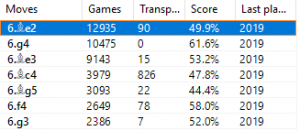The following short overview is an explanation for my clients why I refrain from offering the normal move 6..Bb4 in favor of 6..d6, which leads to the Classical Scheveningen. It serves as a good example for combining several principles for the construction of an opening repertoire. Beside QUALITY, which is always present, you see SIMPLICITY, POSITIONAL DEPTH and VERSATILITY in action. As a consequence, it allows the user to play against inferior opposition in a strategically demanding, but controlled fashion, which will net the full point in the majority of cases. A nice side-effect of this repertoire is that players who lack experience with the Sicilian Defense can learn typical patterns of the Deep Sicilian in the mild waters of the Classical Scheveningen, which is far from critical with its disappointing performance of only 50%.

Position after 1.e4 c5 2.Nf3 e6 3.d4 cxd4 4.Nxd4 Nf6 5.Nc3 d6
[Event "?"]
[Site "?"]
[Date "2019.02.14"]
[Round "?"]
[White "The problem with 6..Bb4"]
[Black "?"]
[Result "*"]
[ECO "B83"]
[Annotator "Wahls"]
[PlyCount "29"]
[EventDate "2018.??.??"]
[SourceVersionDate "2002.05.06"]
1. e4 c5 2. Nf3 e6 3. d4 cxd4 4. Nxd4 Nf6 5. Nc3 Nc6
6. Be2 Bb4 {[#] This move this is recommended by every author on the topic of
the Four Knights. Why not by me? The answer is to be found on the meta-level.
The meta-level deals with the maximization of success, in contrast to the
scientific approach of searching for the truth, or the objectively best move.
While I don't think that 6..Bb4 is objectively worse than 6..d6, I have my
doubts about its meta-level performance. Here are my reasons: 1. After 7.0-0
Black is more or less forced to accept the offered pawn by playing 7..Bxc3 8.
bxc3 Nxe4. The resulting positions are very sharp, and more dangerous for
Black, as White has the initiative. Objectively, this should be okay, but what
if Black didn't make his homework or if he has forgotten his variations? 2.
Then, we have the opposite, as well. Actually, it is in White's hands to opt
for liquidations at various points, which might lead to a draw in 9 of 10
cases. To sum it up: As Black you have to sail around dangerous rocks, and if
you succeed, all you can hope for is a draw. 3. Playing weaker opponents is
another topic. You have to ask yourself: What would I like to accomplish with
Black against inferior players? Normally, the answer should be something like
that: A positionally demanding line, but not too wild, where I have control
and can outplay my opponent in the medium term or in the long run. And what
would you like to avoid? Well, drawish or unclear positions, where a single
mistake can decide the game (coin flip situations). I will now present
examples for these two categories.} 7. O-O Bxc3 (7... O-O 8. Nxc6 bxc6 9. e5
$14) 8. bxc3 Nxe4 9. Bd3 (9. Nxc6 dxc6 10. Qxd8+ Kxd8 11. Bf3 Nf6 12. Rd1+ Bd7
13. Bf4 {is a line where White enjoys a slight initiative and Black basically
is without real winning chances due to the latent presence of opposite
colored bishops.}) 9... d5 10. Nxc6 {That's the most effective way to play
for a draw. One example for a more dangerous line is this one:} (10. Ba3 Qa5
11. Qc1 Nxc3 12. Nb3 $44 {[#] White is two pawns behind, but Black's king will
be stuck in the middle for a while.}) (10. Bxe4 dxe4 11. Ba3 Nxd4 12. cxd4 $44
{is another example for a line with white initiative and a potential draw due
to opposite colored bishops, if Black defends well.}) 10... bxc6 11. Ba3 ({
Slightly less effective, but sufficient was} 11. Bxe4 dxe4 12. Qxd8+ Kxd8 13.
Rd1+ Ke7 14. Ba3+ Kf6 15. Rd6 {with a subsequent draw despite the big
difference in Elo. ½-½ (52) Ashwin,J (2473)-Sutovsky,E (2663) Caleta 2014})
11... c5 12. Bxe4 dxe4 13. Bxc5 Ba6 14. Re1 Qxd1 15. Raxd1 $11 {[#] 1/2 (27)-1/
2 (34) Rublevsky,S (2706)-Tregubov,P (2620) Loo 2014 How do you want to win
this position against an inferior opponent?}
